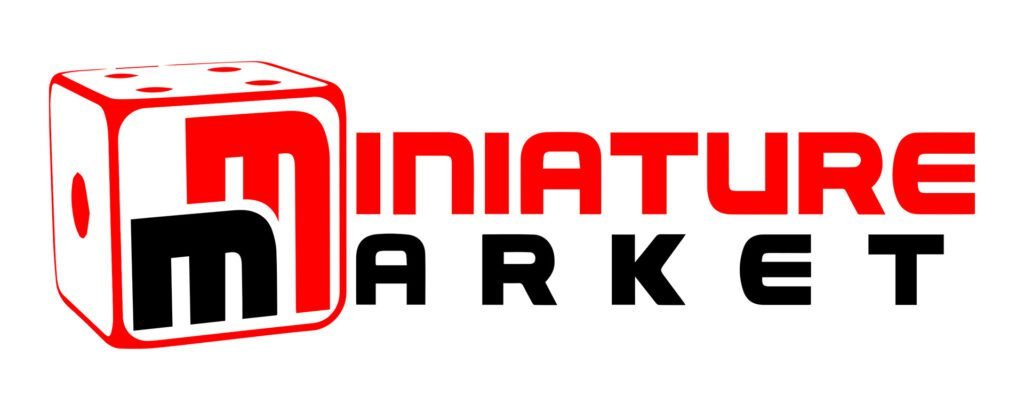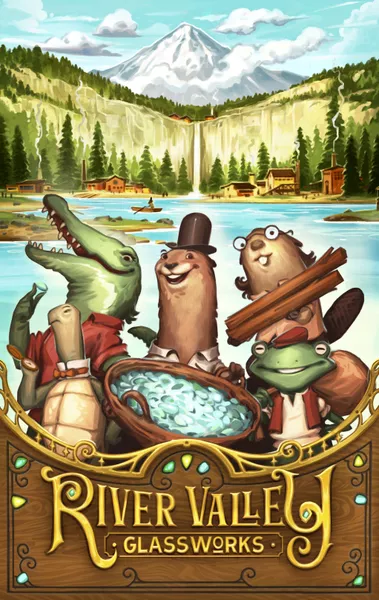
Today we’re diving into River Valley Glassworks. This is a family-friendly board game from Allplay Games, where players take on the role of collectors gathering colorful glass stones from a river to create beautiful displays. So, let’s break it down – what it is, what’s good, what’s bad, & if you should pick it up. Let’s get into it.

What It Is
River Valley Glassworks is a light, family-oriented game where players collect glass stones to create patterns on their personal boards. The game’s simplicity is one of its strongest features, making it highly accessible while still offering layers of strategy. The theme taps into childhood nostalgia, reminiscent of collecting colorful objects, adding an endearing charm to the gameplay.
Check Out These Recent Board Game Sales
- Board Game Sale: Disney Villainous 25% Off!
- Board Game Sale: Marvel: Crisis Protocol Core Set 30% Off!
- Board Game Sale: 7 Wonders Available for 17% Off!
Gameplay Overview
In River Valley Glassworks, players compete to collect glass and arrange it strategically on their boards to score points. The game begins with a setup that includes six shuffled river tiles laid in a row, followed by a lake tile at the end. Glass pieces come in nine colors and six unique shapes, but if playing with fewer than five players, the black glass pieces are returned to the box. After mixing the glass pieces in the included bag, players will randomly draw and place them onto the river and lake tiles as indicated by the stone symbols on each tile.
Each player starts with a double-sided glassworks board, a satchel, and a marker. The satchel holds three random glass pieces at the start, and the marker is placed on the zero space of the inventory track on the side of the board. The game is played over several turns, beginning with the player who last saw a river or by assigning the first player token randomly. The goal is to collect and arrange glass pieces to fill rows and columns on the player’s board, aiming for the highest score by the end of the game.
On each turn, players can choose one of two actions: placing and gathering or drawing glass. To place and gather, the player selects a glass piece from their satchel, paying attention to its shape rather than color, and places it on the corresponding river tile. Then, they gather all the glass pieces from one of the adjacent river tiles. If a player has two glass pieces of the same shape, they can place both on any tile and then gather glass from an adjacent tile. After gathering, the empty tile is moved to the farthest end from the lake, and glass pieces are drawn from the bag to restock the empty tile.
When placing glass on the board, the player must prioritize color. The first piece of a new color must go into the bottom space of the leftmost empty column, while additional pieces of the same color are placed above the previous ones. The inventory track is updated to reflect the total number of glass pieces on the board, excluding any in the overflow area. Players need to manage their glass pieces carefully, as once the board fills up, excess pieces that cannot fit into valid rows or columns must go into the overflow, which negatively affects scoring.
The second possible action is drawing glass from the lake. A player can collect four glass pieces from the lake and add them to their satchel. However, if the satchel exceeds five pieces, they must move any excess into the overflow area. After drawing from the lake, the lake is refilled with glass pieces drawn randomly from the bag. The game continues with players alternating turns, either placing and gathering or drawing, until one player reaches or exceeds 17 glass pieces on their board, triggering the endgame.
Final scoring involves calculating points from both rows and columns. For a row to score, it must be complete, starting from the leftmost space and moving to the right without gaps. The points awarded depend on the number of glass pieces in the row before any gaps. Similarly, columns are scored based on their height, with the two tallest columns earning points. If two columns are tied in height, the leftmost column scores. Players also lose three points for each glass piece in their overflow area.
Striking a balance between filling rows and creating tall columns is crucial for maximizing points. The rightmost columns offer higher points, but focusing too much on these can create gaps in the rows, reducing their value. Different colors of glass are more or less common, with white and pink being the most abundant, while yellow and orange are rarer. This color distribution adds another layer of strategy to the game. The game also includes solo play rules, where players face off against different rivals with unique challenges, though the details of solo play are left for players to explore.
Overall, River Valley Glassworks provides a satisfying blend of strategy and resource management, challenging players to collect and arrange glass pieces efficiently while navigating the puzzle-like mechanics of filling rows and columns.
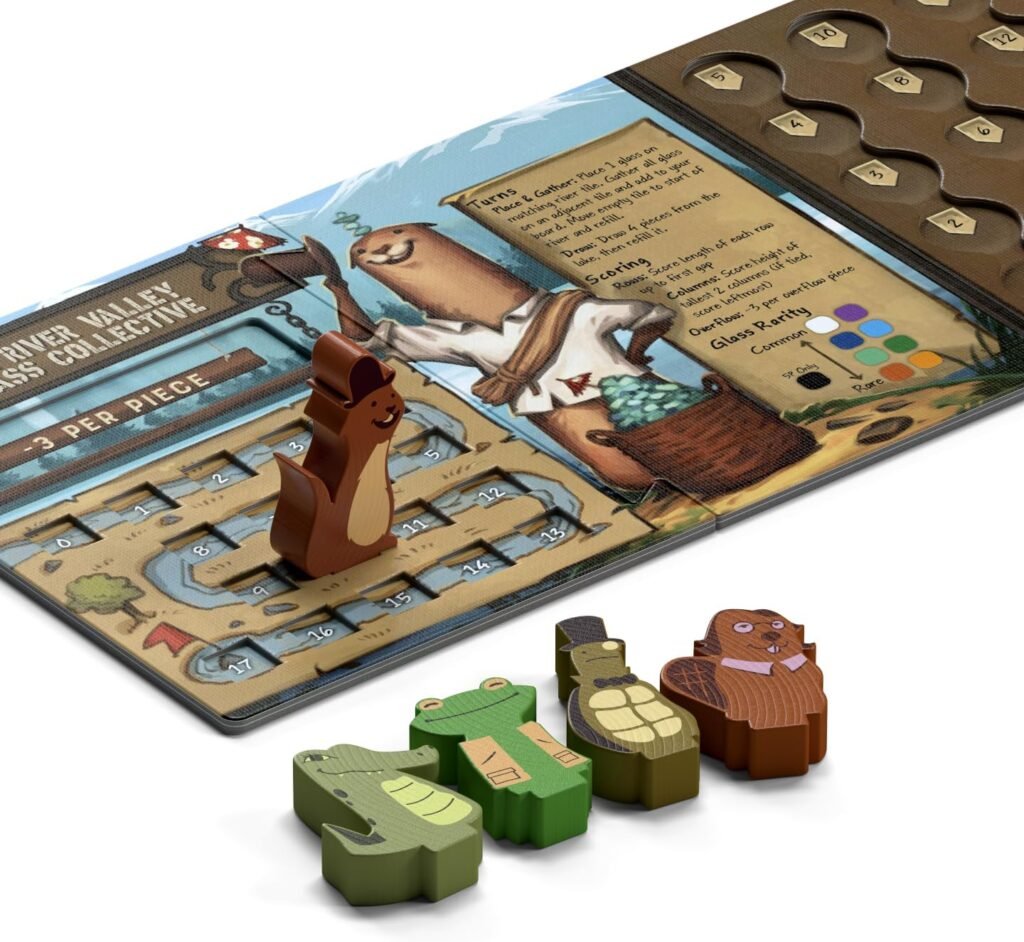
The Components
Visually, the game shines with its colorful glass stones, which are easily the star of the production. These stones resemble hearts & diamonds, giving the game a subtle, naturalistic appeal. The board, representing a river, is simple but functional, & each player’s personal board helps organize the stones while providing helpful reminders about scoring. The addition of cute animal avatars adds to the game’s charm. Allplay’s attention to detail shows through in the design, making this game as pleasant to look at as it is to play.
The Good
One of River Valley Glassworks’ greatest strengths is its accessibility. The mechanics are straightforward enough for beginners or younger players, but the game doesn’t lose strategic depth as a result. Its simple actions, like choosing stones & placing them in columns, make it easy to pick up, but players quickly realize there’s a lot of decision-making required to score effectively. This blend of easy-to-teach mechanics with hidden depth makes the game a fantastic option for family game nights or mixed skill groups.
Another highlight is the game’s aesthetic & tactile appeal. The glass stones are not only visually pleasing but also satisfying to handle, adding a tactile element to the game. The short playtime of around 20 minutes also works in its favor, allowing for multiple rounds in a session without feeling too repetitive. These quick sessions, combined with its engaging decisions, make the game replayable & enjoyable even after several plays.
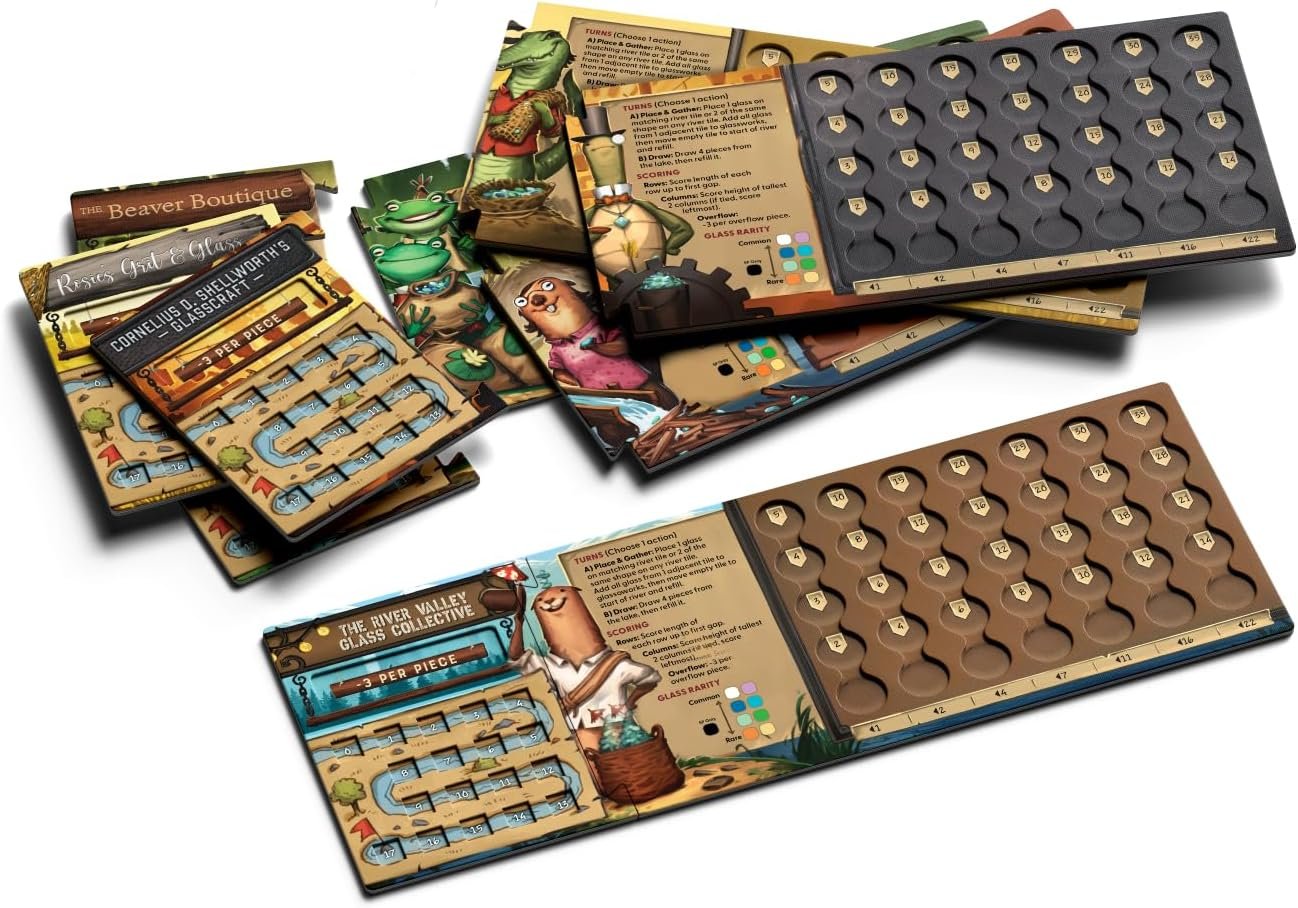
The Bad
While River Valley Glassworks does offer depth, some players may find its constraints limiting. The fixed number of columns & the rule that stones of the same color must go in the same column can feel restrictive, particularly for those who prefer games with more open-ended choices. This rigidity can sometimes make the game feel repetitive, especially if you’re someone who enjoys constantly evolving strategies.
Additionally, luck plays a role in determining who gets access to the rarest stones, which might frustrate players looking for more control. The scarcity of certain colors means that some games might boil down to which player had better access to these high-scoring stones, introducing an element of randomness that might detract from the strategic appeal for some. However, this only becomes an issue in certain games & doesn’t usually overshadow the enjoyable core mechanics.
The Verdict
River Valley Glassworks shines as a light, quick, & accessible game perfect for a wide range of players. Its core mechanics are simple, but there’s enough strategic depth to keep more experienced players engaged. The charming components, short playtime, & tactile pleasure of collecting glass stones make it an easy game to bring to the table repeatedly, especially for family or casual gaming groups. The fact that it can be enjoyed by players of various ages is a huge plus, & its low barrier to entry makes it an excellent gateway game.
However, the game’s limited scope & occasional reliance on luck may deter players seeking deeper, more complex experiences. The fixed board setup & repetitive mechanics might wear thin after several plays if you’re looking for a game with evolving strategies or unpredictable gameplay. Still, for what it sets out to do, River Valley Glassworks delivers a charming, quick, & satisfying experience that will appeal to many.
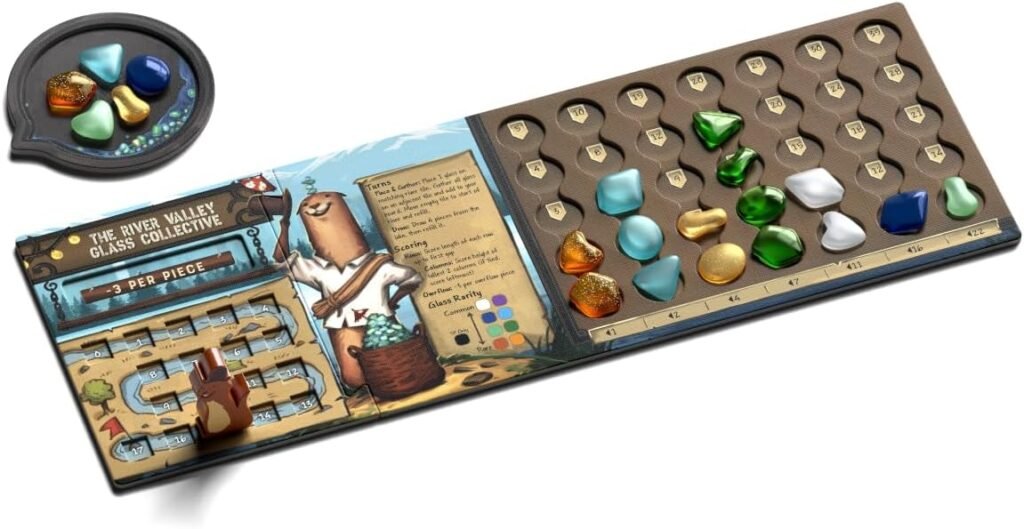
Final Thoughts
After spending a few rounds with River Valley Glassworks, I can honestly say I had a good time with it. The game is really easy to jump into, which made teaching it to my group a breeze. The rules are simple—collect stones and place them in patterns on your board—but that doesn’t mean the game lacks strategy. In fact, I found myself thinking a lot more than I expected about how to balance my rows and columns, and that little bit of puzzle-solving made each turn feel satisfying.
The component quality also added to the experience. Those glass stones are surprisingly fun to handle, and there’s something nice about the way the game looks on the table. It kind of gives off a calming vibe, which matches the gameplay. It’s the type of game where you can chat and relax without getting too bogged down in rules or complex decisions, but there’s still enough going on to keep everyone engaged. My group appreciated that, especially when we were winding down after a longer, more intense game.
One of the things I really liked was the balance between short-term and long-term decisions. Do you finish up a row to get points now, or focus on building taller columns for the end-game bonus? I liked that tension, even though sometimes I’d make a move that came back to bite me later. There’s also a bit of a risk with managing your stones, since collecting too many can land you in the overflow zone, which definitely added a little spice to an otherwise chill experience.
Now, I’ll say this: if you’re someone who needs a lot of complexity and variety in your games, you might find this one a bit repetitive after a few plays. The gameplay is solid, but it doesn’t really evolve much from start to finish. Personally, I enjoyed it, but I can see how some people might feel like they’re doing the same thing over and over, especially after multiple sessions.
What stood out the most to me was how flexible River Valley Glassworks is. I played it with a mix of casual and more experienced players, and everyone seemed to enjoy it. It’s great for families or groups where not everyone is a hardcore gamer, but even seasoned players can appreciate the little strategic decisions that pop up throughout the game. The short playtime is a big plus too, making it an easy one to pull out when you don’t want to commit to a longer game.
Overall, I’d say River Valley Glassworks does exactly what it sets out to do: it’s a light, fun game with just enough strategy to keep things interesting. It’s not trying to reinvent the wheel, but sometimes that’s exactly what you want. If you’re looking for a quick, easy-to-teach game with some nice table presence and a laid-back vibe, this one’s worth checking out. It won’t be the main event for game night, but it’ll definitely hold its own as a great filler or family game.
Purchase Options


At no extra cost to you, The Board Game Site may receive revenue from affiliate and advertising partnerships for sharing this content and from purchases through links.



